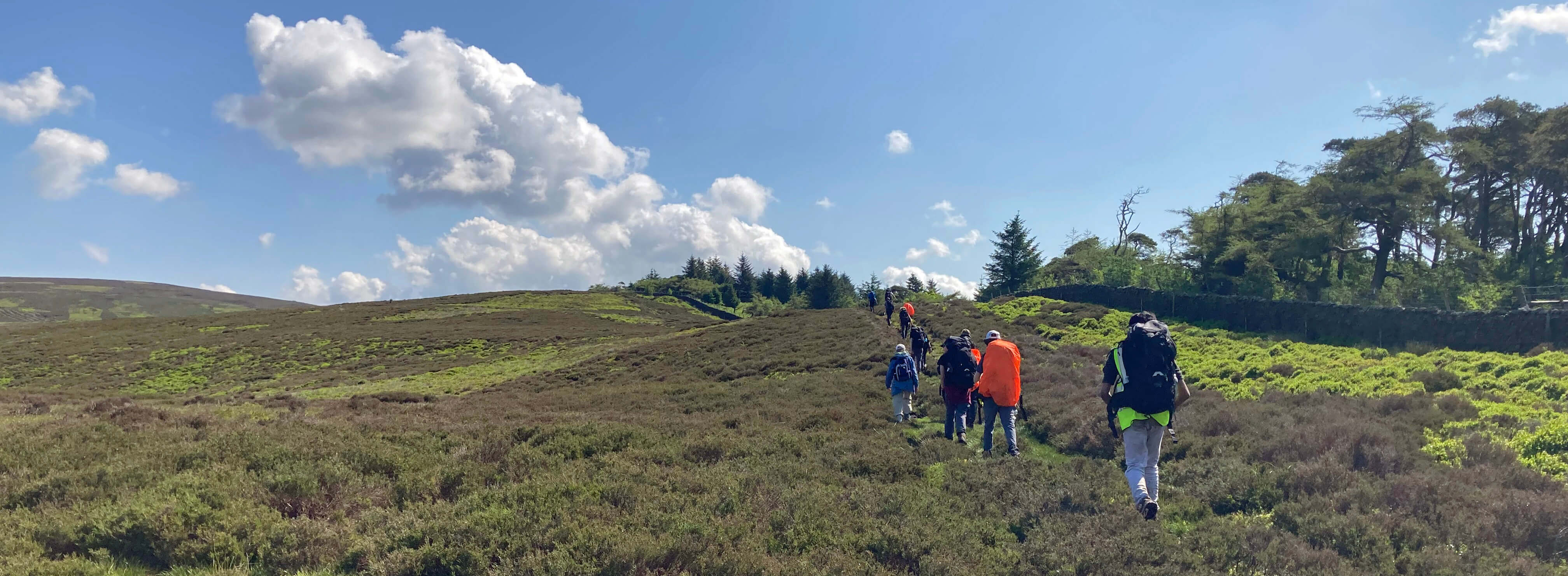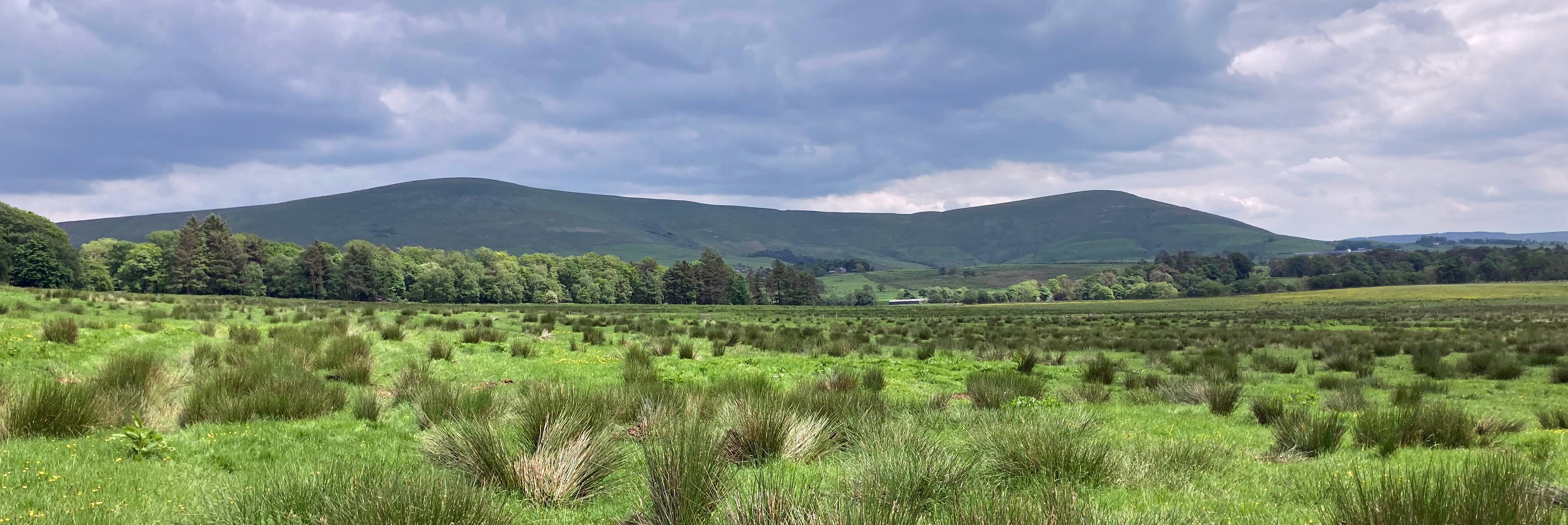
Home
Preamble
Index
Areas
Hills
Lakes
Dales
Map
References
Me
Drakkar
Saunterings: Walking in North-West England
Saunterings is a set of reflections based upon walks around the counties of Cumbria, Lancashire and
North Yorkshire in North-West England
(as defined in the Preamble).
Here is a list of all Saunterings so far.
If you'd like to give a comment, correction or update (all are very welcome) or to
be notified by email when a new item is posted - please send an email to johnselfdrakkar@gmail.com.
200. Up Hazelhurst Fell in the New National Landscape
For our first walk on the fells for six months (since Pen-y-ghent
(Sauntering 189)), we set off from the Delph Lane car-park towards Stang
Yule and then on to Oakenclough Fell. We were passed by a group of a dozen or so youngsters who
looked prepared for a long trek. I asked a lad where they were going and he waved airily
to the right, without much enthusiasm. Anyway, I’m sure that they were walking further
than us, as we were on a modest, tentative outing.

The path past Fell Plantation
A good, gentle track took us up past Fell Plantation, which has been largely deforested,
and then up the slopes of Hazelhurst Fell. Views opened out of the green fields of
Bleasdale below Fair Snape and Parlick (which we had walked up in
Sauntering 109 between the covid lockdowns) but it was too hazy to see
much in the distance. We could just about see Morecambe Bay but not the Lake District hills.
The bilberry seemed deep green and our impression was that there were fewer sheep
than there used to be to nibble it. Apart from the occasional curlew, it was quiet. We heard
no skylarks and no cuckoos. We saw one grouse. Maybe we are less observant than we were
but it seems that these hills, while perfectly pleasant to walk upon, with fine views, are
something of an ecological desert. Maybe the new status of the region will make a difference.

Fair Snape and Parlick from Hazelhurst Fell
On our earlier walks in this region it was part of the Forest of Bowland Area of
Outstanding Natural Beauty. In Sauntering 99
I queried the word ‘natural’ since these hills are severely managed for grouse-shooting,
which entailed the regular burning of the heather and the elimination of predators such as
stoats and hen harriers. In Sauntering 109 I queried the ‘beauty’
as well: “What's beauty got to do with it, anyway? Whether or not I or you consider
Bowland to be a region of beauty is neither here nor there. Emphasising ‘beauty’ puts
us and our subjective opinion at the forefront when the key factor in the designation
of regions for protection should not be our aesthetics but its biodiversity and ecology.
In this respect Bowland is sadly lacking.”
In November 2023 it was decided that the Forest of Bowland would no longer be an
Area of Outstanding Natural Beauty. It would be rebranded as a National Landscape.
The ‘natural’ and the ‘beauty’ have gone. (I don’t claim all the credit.) In fact,
all AONBs would now be National Landscapes.
 Right: The new Forest of Bowland National Landscape logo, replacing the old AONB one depicting
a hen harrier, which is just as well as hen harriers have become scarce
(I leave you to decide what the new logo depicts).
Right: The new Forest of Bowland National Landscape logo, replacing the old AONB one depicting
a hen harrier, which is just as well as hen harriers have become scarce
(I leave you to decide what the new logo depicts).
What is the significance of this change? The ‘National’ does, I suppose,
confirm that the regions are, like National Parks, of national, rather than just local,
significance. The titles
of AONB and National Park were and are legal designations. Is there a suggestion that
National Landscapes would have greater legal powers akin to those of
National Parks? This would, I assume, require an Act of Parliament and I am
not aware of any such Act. So, for the moment, I am assuming that National Landscapes
have inherited the same legal powers as the old AONBs, that is, rather limited ones.
There is also a hint that the National Landscape designation will entail the
allocation of greater resources, on a par with National Parks. Again, I am not aware
that the government has said this – and, in fact, I doubt that the present government
would do so. The
government’s response
(January 2022) to a review of National Parks and AONBs commented that:
“[the latter] are just as important for people and nature [as the former] but lack
equivalent recognition in law or support in resources.”
However, it did not commit, as far as I can see from the document, to doing anything about this.
So, in practical and legal terms, the rebranding may be just that – just a change
of name. However, the National Landscape managers have taken the opportunity to re-express
their mission.
The Forest
of Bowland National Landscape team's
response
to the new designation says:
“the National Landscapes’ vision [is] to be the leading exemplars of how thriving, diverse communities
can work with and for nature in the UK: restoring ecosystems, providing food, storing carbon
to mitigate the effects of climate change, safeguarding against drought and flooding, whilst
also nurturing people’s health and wellbeing.”
That all sounds commendable. We can only hope that it amounts to more than platitudes.
Will the rebranding affect the public’s subjective appreciation of the National
Landscapes? The ‘beauty’ in the AONB title did rather encourage us to think
that these were just regions to visit to look at. I’m not sure that the word ‘landscape’
is any better in this respect. For most of us, a landscape is something to be looked at.
However, as discussed in Sauntering 68, the concept of landscape
can be broad and complex. Perhaps the new name will help us towards a richer appreciation
of landscape. Overall, I agree that the AONB designation had outlived its usefulness.
Perhaps we can rebrand the Sites of Special Scientific Interest too?

Looking towards Hazelhurst (centre foreground) and Beacon Fell (beyond)
After crossing Clough Heads Brook the track across Hazelhurst Fell continues to a
key point for Bowland walkers, Fiendsdale Head, from which a path continues into
Langdendale (walked in Sauntering 180) and a way may be found
across peat bogs to Fair Snape. But this was as far as we were going. We dropped down to
pick up the public footpath to the farm of Hazelhurst. On the way we saw a hare plus leveret, so
perhaps it is not such a wildlife desert after all.
The walk west from Hazelhurst, along tracks and through woods, past Bleasdale
Tower (built in the 1840s), across fields and around (rather than through as shown on
my map) Broadgate and High Moor was uneventful. Decade by decade, Bleasdale hardly
seems to change. It is a quiet haven of green pastures sheltered within the arc of
Hazelhurst Fell, Fair Snape and Parlick. I doubt that becoming part of a National Landscape
will change Bleasdale much.

Bleasdale Tower

A look back to Fair Snape and Parlick
Date: May 25th 2024
Start: SD546455, Delph Lane car-park (Map: OL41)
Route: N – Stang Yule – NE above Fell Plantation and across
Hazelhurst Fell, SW on track, SE – public footpath – S, W – Hazelhurst – SW through
Clough Heads Wood, past Bleasdale Tower, through Broadgate Wood, around Broadgate and
High Moor – Delph Lane – N – car-park
Distance: 6 miles; Ascent: 230 metres
Home
Preamble
Index
Areas
Hills
Lakes
Dales
Map
References
Me
Drakkar
© John Self, Drakkar Press, 2018-

Top photo: The western Howgills from Dillicar;
Bottom photo: Blencathra from Great Mell Fell




 Right: The new Forest of Bowland National Landscape logo, replacing the old AONB one depicting
a hen harrier, which is just as well as hen harriers have become scarce
(I leave you to decide what the new logo depicts).
Right: The new Forest of Bowland National Landscape logo, replacing the old AONB one depicting
a hen harrier, which is just as well as hen harriers have become scarce
(I leave you to decide what the new logo depicts).



